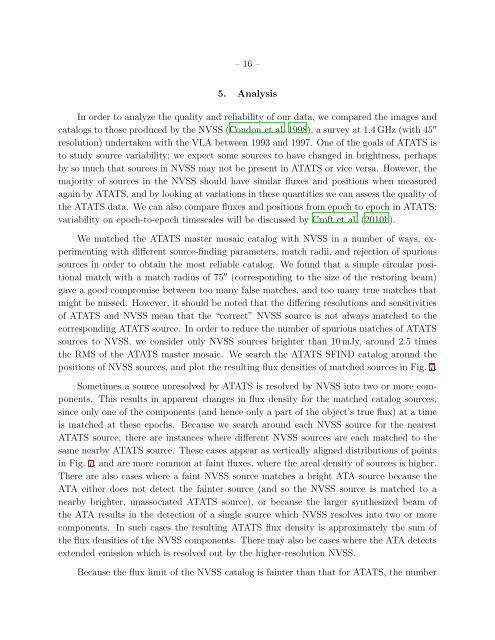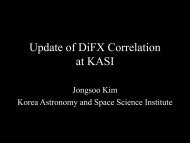The Allen Telescope Array Twenty-centimeter Survey—A - CIRA
The Allen Telescope Array Twenty-centimeter Survey—A - CIRA
The Allen Telescope Array Twenty-centimeter Survey—A - CIRA
Create successful ePaper yourself
Turn your PDF publications into a flip-book with our unique Google optimized e-Paper software.
– 16 –<br />
5. Analysis<br />
In order to analyze the quality and reliability of our data, we compared the images and<br />
catalogs to those produced by the NVSS (Condon et al. 1998), a survey at 1.4GHz (with 45 ′′<br />
resolution) undertaken with the VLA between 1993 and 1997. One of the goals of ATATS is<br />
to study source variability; we expect some sources to have changed in brightness, perhaps<br />
by so much that sources in NVSS may not be present in ATATS or vice versa. However, the<br />
majority of sources in the NVSS should have similar fluxes and positions when measured<br />
again by ATATS, and by looking at variations in these quantities we can assess the quality of<br />
the ATATS data. We can also compare fluxes and positions from epoch to epoch in ATATS;<br />
variability on epoch-to-epoch timescales will be discussed by Croft et al. (2010b).<br />
We matched the ATATS master mosaic catalog with NVSS in a number of ways, experimenting<br />
with different source-finding parameters, match radii, and rejection of spurious<br />
sources in order to obtain the most reliable catalog. We found that a simple circular positional<br />
match with a match radius of 75 ′′ (corresponding to the size of the restoring beam)<br />
gave a good compromise between too many false matches, and too many true matches that<br />
might be missed. However, it should be noted that the differing resolutions and sensitivities<br />
of ATATS and NVSS mean that the “correct” NVSS source is not always matched to the<br />
corresponding ATATS source. In order to reduce the number of spurious matches of ATATS<br />
sources to NVSS, we consider only NVSS sources brighter than 10mJy, around 2.5 times<br />
the RMS of the ATATS master mosaic. We search the ATATS SFIND catalog around the<br />
positions of NVSS sources, and plot the resulting flux densities of matched sources in Fig. 7.<br />
Sometimes a source unresolved by ATATS is resolved by NVSS into two or more components.<br />
This results in apparent changes in flux density for the matched catalog sources,<br />
since only one of the components (and hence only a part of the object’s true flux) at a time<br />
is matched at these epochs. Because we search around each NVSS source for the nearest<br />
ATATS source, there are instances where different NVSS sources are each matched to the<br />
same nearby ATATS source. <strong>The</strong>se cases appear as vertically aligned distributions of points<br />
in Fig. 7, and are more common at faint fluxes, where the areal density of sources is higher.<br />
<strong>The</strong>re are also cases where a faint NVSS source matches a bright ATA source because the<br />
ATA either does not detect the fainter source (and so the NVSS source is matched to a<br />
nearby brighter, unassociated ATATS source), or because the larger synthesized beam of<br />
the ATA results in the detection of a single source which NVSS resolves into two or more<br />
components. In such cases the resulting ATATS flux density is approximately the sum of<br />
the flux densities of the NVSS components. <strong>The</strong>re may also be cases where the ATA detects<br />
extended emission which is resolved out by the higher-resolution NVSS.<br />
Because the flux limit of the NVSS catalog is fainter than that for ATATS, the number



